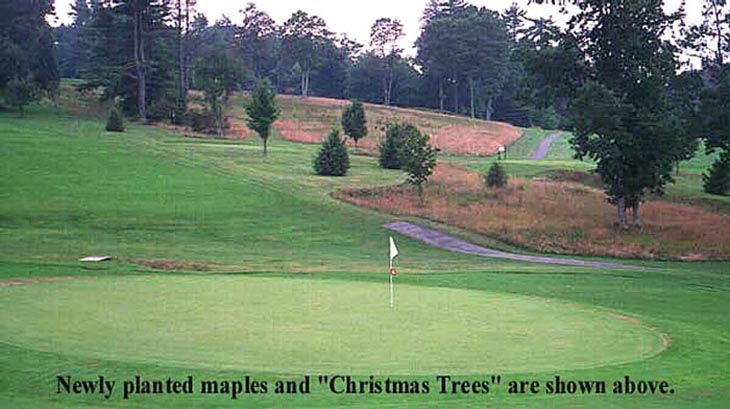An Anatomy of a Restoration
by Dunlop White III
Club members often lobby for changes and additions to their golf course. Green committees frequently respond by altering their golf course in a careless and discriminant manner. Golf professionals, greens superintendents, greens chairmen and club members all have various personal agendas. Everyone ultimately will offer new bright ideas and try their hand at golf architecture and redesign.
Low handicappers usually will promote high rough, because they tend to believe that their course has become too easy. Similarly, low handicappers are obsessed with length. They will insist on moving tee areas backwards to create more distance and help defend par. Low handicappers generally want to create a “championship” layout at their home course so they narrow the fairways and squeeze the landing areas. In contrast, high handicapper will want shorter rough and even wider fairways. The high handicapper may want to move some tedious bunkers or may simply want to level some engaging mounds. Moreover, “slicers” will add more hazards to the left side of a fairway while “hookers” will add more hazards to the right side of the fairway. Superintendents also change golf courses through maintenance practices. Other times, courses are intentionally altered to alleviate maintenance costs. What a mess!
In the early 1980’s, aesthetics was the growing rage across golf courses in America. Everyone thought green, green and more green. Everyone wanted to capture the “plush look”. As a result, excessive drainage channels were constructed, excessive water was applied, new cart paths were added or old ones were rerouted, and many new shrubs started taking root. Then there were flowerbeds and birdhouses as yardage markers. Of course, metal spikes would be required at all times. Incidentally, walking the golf course would be restricted as well. In order to generate revenue, cart-use would be required during weekends and most hours of the weekdays. Just make sure you follow the many “directional signs” which are presently posted throughout your course. Use your sand-and-seed containers to help the course, and use your digital distance finder to help your game. Of course, new turf grasses are always available; present green speeds are never fast enough; and multi-row irrigation systems can currently water every square inch of the property. Make sure your club owns the state-of-the-art, quinplex mower though! All of the above does, in fact, compromise playability and design integrity, but perhaps none more than “ornamental and memorial tree planting programs”.
Below the Trees
Today, trees are the most beautiful features on many great golf courses across America. In this modern era of golf course design, trees function to serve many diverse purposes. Trees are often used as “safety buffers” between adjacent holes. Trees similarly serve as “visual or sound barriers”. Trees further promote the growing issues of wildlife habitat and lend an aesthetic value to the course setting. Trees assist the golfer with “shot selection, shot direction and shot execution”. Trees are the most prevalent of modern day hazards, and once engaged, trees may very well be the most penal.
Trees are the most difficult hazard for the golfer to avoid. Classic architects incorporated such hazards as grass bunkers, sand bunkers, ravines, creeks, and fescues for rough. These types of hazards are only “two-dimensional”. The golfer only needed to calculate proper line and distance when negotiating with the common hazards of the classical design. The modern design, however, incorporates many more trees into play. Trees are “three-dimensional” hazards. The golfer must calculate not only line and distance when negotiating with trees, but the golfer must also figure altitude into the pre-shot equation. Three-dimensional hazards, exemplified by trees, are naturally more difficult to avoid and recover therefrom than the traditional two-dimensional hazards.
Trees magnify and compound the inherent differences between the modern and classic course design and the playability thereof. Pioneers of the classic design did not believe that the game of golf needed trees. Donald Ross, for instance, believed that the game of golf should be played on the ground. “High carries, long carries, and the element of altitude were not a forced consideration” while playing a Ross design. Straight shots down the center of the fairway were not forced either. Fairways were typically open and wide, approximately 80 yards in width. Run-up shots were often available with many alternative routs to the hole. There were preferred lines of play; however, these lines may differ between golfers or differ for golfers on different days.
Geoff Shackelford, noted author and design consultant, reiterates that classic architects built holes “where there was no right way or clear way to play them”. If there was a “right way”, certainly there was never an agreement of opinion. Spacious fairways provided golfers with strategic choices and options”. These courses were thought provoking and the true challenge was presented at the greens where different angles were available for their approach. There was room to play and decisions to be made on every shot. Strategy was the essential ingredient of a classic design. Bruce Hepner, golf architect for Renaissance Golf Design, stated that nothing has negated the strategic value of a classic design more than the loss of fairway acreage due to tree plantings and overgrowth.
Conversely, modern course designs will likely maintain trees in close proximity guarding both sides of a fairway and other landing areas. The golfer has only one option to play such a hole. He or she has no choice but to hit it straight, to a precise distance, using a required club. In the era of modern design, successful golfers are forced into becoming target golfers who must strictly abide by the policies of shot- placement. Olsen, a former USGA agronomist, coined the phrase that modern golf courses have become “bow and arrow courses” due to the fact that a good shot is restricted to the dead center. Modern holes tend to be linear, both straight and narrow (often just 35 yards in width). With straight patterns of trees framing the fairways they took on a “freeway” look. Bailout areas are not usually available and risky shots are often too penal for its reward. The art and creativity of classic shot making is lost when the course design presents the golfer with only one reasonable option to play a hole. Thus, the presence or absence of trees determines a golfer’s options and effectively distinguishes a classic design from a typical modern design.
Do new trees really belong on our course at Blackacre Golf Club? (Hereinafter: Blackacre) Who decides where these trees should be planted? Are new trees and overgrowth not narrowing our playing areas? Is our classic design at prey to the influences and perceptions of modernization? Shouldn’t preservation of our maker’s design and his philosophies be our goal?
In 1994 our excellent greens superintendent reported that “an extensive tree planting program continued on our course at Blackacre”. The following variety of trees were planted in various locations: Eastern Hemlock, Red Maple, Sugar Maple, White Oak, and the Eastern White Pine. A grand total of fifty-two (52) new saplings were planted in that year alone, thirty-five (35) of which were of the evergreen, holiday variety. During the 1995 green’s committee meeting, we learned that ‘Mrs. Jones’ had donated trees, which were to be re-planted on the golf course. Our superintendent further indicated that memorial tree plantings were to be encouraged. In 1996, our superintendent along with a lady member in charge of ornamental tree plantings informed the committee that trees had been planted during the off-season “to beautify and attract beneficial wildlife to our golf surroundings”. He reported that “tree plantings this year not only included the use of Hemlocks, Evergreens, and the Colorado and Norwegian Spruces, but also the American Beech was added which is one of the finest in the tree species’…’this tree, native to various surrounding areas, is of the most spectacular of golf course specimens’…’it provides both a housing habitat and a food source for wildlife”. He further noted “dead trees are left standing where possible, because they help build topsoil as they decompose, and they also harbor insects which provide a food source for various woodpeckers and nuthatches”. Wow!
Nonetheless, every summer we find new trees about our course at Blackacre. Perhaps some of these trees are arbitrarily planted along traditional landing areas. Or perhaps someone sought to place his/her stamp on a hole to make it play more difficult. Or perhaps these new trees are a result of environmental and beautification measures. Regardless of the reason, these trees don’t belong!!
Patrick O’Brien, Director of the Southeast Section of the USGA, has been employed by our club to provide advice for golf course improvement and to assist with turf-grass management. Mr. O’Brien visited Blackacre in November of 1996 and August of 1997, the latter of which Mr. O’Brien alerted me of his distaste of tree plantings. As he viewed young trees about our golf course, Mr. O’Brien inquired, “What is wrong with having open spaces?” He claimed that tree planting committees have ruined many classic Donald Ross’ designs and encouraged us to leave our “open golf spaces” alone. In particular, Mr. O’Brien disapproved of the new trees on both side of hole nine(9), the trees to the right side of hole(10), and the young trees to the left side of sixteen(16) fairway. Mr. O’Brien also displayed his distaste for the young tree at the corner of the dogleg on hole three(3) and the rows of pines which now buffer holes fifteen(15) from sixteen(16) as well as holes seventeen(17) from eighteen(18). Mr. O’Brien encouraged me to research the matter, and after doing so, I wholeheartedly agree with his professional opinion.
Bradley Klein offers a popular view of tree plantings about the golfing arena. Klein presently serves as the golf architectural and design editor for “Golfweek” and “Superintendent News” publications. He is also a contributing columnist for “Golf Digest” and “Sports Illustrated”. There are few, if any, who are more knowledgeable of the Donald Ross philosophy. Klein is a member of Donald Ross’ home course, Royal Dornoch in Scotland, and serves on the historical committee of the Donald Ross Society. He is also the author of two books, “Rough Meditations” and “Discovering Donald Ross”. Klein stated that it is easy to get upset about new trees on golf courses, because they simply don’t belong. Klein further writes:
“Great damage can be done to a golf course in the name of ornamental tree plantings. Sometimes the argument is for safety between holes. Other times, the membership is determined to make – or keep – its golf course tough. But too often the plantings detract from the design. Among the worst offenders are those who specialize in course beautification. One of the most prominent of these, run by well-intentioned folks who neither golf nor understand golf strategy, consistently recommends an aggressive program that becomes tantamount to filling up every available space, even if it means with little dopey Christmas trees 10 yards off the fairway….yet there is too much evidence of recent tree plantings, many of them alongside the landing areas of tee shots, or to block long hitters from carrying the inside of doglegs….Such tampering gradually puts at risk a wondrous piece of natural strategic contouring and subtly forces its artful ground game into a less subtle version of modern target golf”.
Harry S. Colt, a famous architect who designed Royal Portrush in Ireland and Swindley Forest in England, believed that the presence of trees on golf courses created too many inequities for the players. Colt reiterated in his Essays on Golf Course Architecture that “a tree is fluky and obnoxious form of a hazard….”, because a tree can obstruct and/or stymie one ball without even affecting another ball located just a couple of feet away. According to Colt, a tree’s primary function was merely to distinguish between those players who had good or bad fortune.
Even Allister Mackenzie, one of the most renowned golf architects, stated his disinterest in trees “….there are more mistakes in designing a golf course by attaching too much importance to the element of luck…and there is too much of that very element…in having to negotiate with trees”. Mackenzie further stated that a green committee’s most common misuse of trees was to plant rows of midget evergreens between holes as a safety buffer. The rows of pines between hole fifteen(15) and sixteen(16) as well as seventeen(17) and eighteen(18) at Blackacre automatically come to mind.
In The Lost Commentaries of Legendary Golf Architect, Donald Ross, it was initially apparent that Ross found that trees obstructed play. Donald Ross, a Scotsman, learned the game and its virtues on courses like Dornoch, Prestwick and St. Andrews, where the tree itself was never a factor. When Donald Ross designed the legendary courses of Oak Hill and Oakland Hills, the land used was barren and void of trees. Even when Ross designed Blackacre in 1926, old photographs reveal that a large portion of our mountaintop was essentially meadow and pasture land. Ross states in his Lost Commentaries: “As beautiful as trees are and as fond as you and I are of them, we still must not lose sight of the fact that there is a limited place for them in golf”. Donald Ross believed that trees could be used as a backdrop to visually frame a hole. Most importantly, however, Ross insists that trees should not be used for penal purposes on a golf course. Trees should serve perhaps as the scenery, but never as part of the stage.
Planting new trees beside traditional playing spaces also compounds the difference between low and high handicappers. These new trees generally do not affect the low handicapper. The low handicapper has the ability to avoid new trees as potential obstructions and is forced into abiding by the monotonous principles of course management. The player has but one option and strategy to playing a hole – hitting it straight to a precise distance using a required club. This characteristic is foreign to a classic Ross design.
Conversely, new trees tend to obstruct the high handicappers more often. The high handicapper usually does not recognize the risk of obstruction, does not have the skill to avoid these obstructions, and cannot recover from these obstructions once engaged. Therefore, new trees to a high handicapper are inherently penal, also a characteristic foreign to a Ross design.
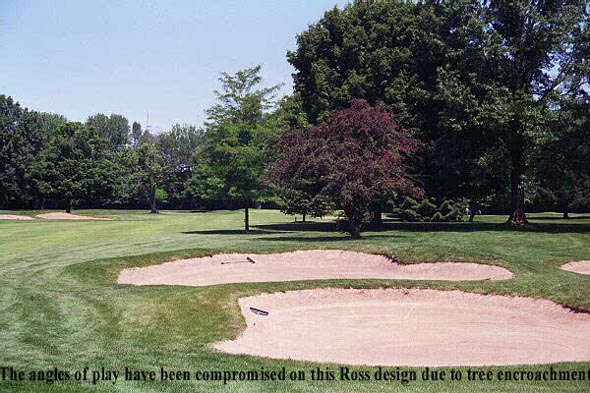
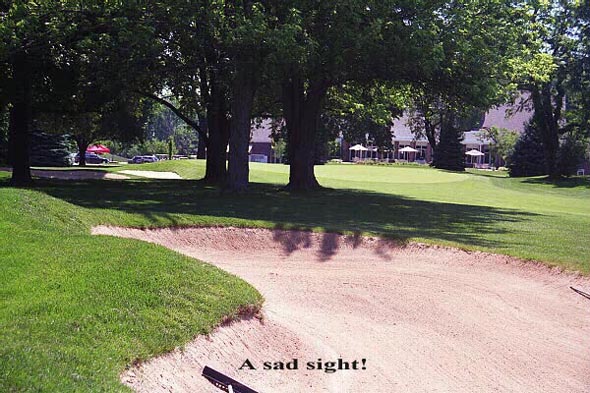
What was the impetus to plant unnecessary and strategically improper trees on classic designs? Michael Fay, Secretary of the Donald Ross Society and author of the book, “Golf, As It was Meant To Be Played”, maintains a plausible theory which he calls the “Pine Valley Effect”. Over the years many well-to-do and connected golfers made their way to Pine Valley, a vaunted and respected ground for the game. Most of these golfers have always been impressed by the fact that one hole cannot be seen from another at Pine Valley. Unfortunately, too many of these influential individuals returned to their home clubs and started tree planting programs to try to create the Pine Valley look. The problem with this, according to Fay, is that Pine Valley’s golf course sits on over three-hundred(300) acres of land while the average classic course contains anywhere from ninety(90) to one hundred and ten(110) acres. Separating the holes with trees on only one-hundred(100) acres of land inevitably will affect play. Ironically, our course at Blackacre sits upon far less than one-hundred(300) acres and some of our members are members of Pine Valley as well. Thus, Fay’s theory perhaps has validity.
Now add another contributing factor: golf course irrigation. The classic Ross design was built before the advent of complete irrigation systems. Originally, a Ross fairway tended to be open, wide and elaborately curved. However, after the widespread adoption of full-length, single row irrigation systems constructed down the middle of fairways, these fairways consequently lost their width and curvature. The exact length of the water’s throw (usually 20 to 25 yards on both sides) gradually became the demarcation lines for the fairway, particularly since the grass in this area was greener. Thus, open, wide fairways became narrow, and their elaborate contours and curvatures evolved into straight lines. As a result, trees were planted in the lateral playing areas of light rough, the areas which could not be irrigated. Brad Klein, in ‘Discovering Donald Ross’, admits that all too many peripheral bunkers and lateral playing spaces have since been abandoned, covered-up, or overgrown by trees. Unfortunately, today’s golfer has lost appreciation for the width and strategic variety which existed before irrigation. According to Klein, complete irrigation systems precipitated the narrow, linear, tree-lined, parkland look, which unfortunately exists on too many Ross courses today.
If planting trees on the golf course is necessary at Blackacre, then standard golf landscaping principles should be recognized. Planting trees too close to tees and/or greens inhibits turf-grass functions, thus from an agronomic viewpoint, these locations are to be avoided. Planting new trees to both sides of typical landing areas promotes target golf, thus from a strategic standpoint, these locations are to be avoided. P. J. Boatwright, past president of the USGA, became a tree expert during his tenure of grooming US Open venues. His strategy is respected among golf architects and restorationists today. According to Boatwright, trees may exist between typical hitting areas and typical landing areas. These trees cannot obstruct and/or stymie the next shot. Instead, these trees will affect the curvature or trajectory of the next shot in proportion to the error of the drive. Thus, planting trees before and/or beyond typical landing areas advances the classical attributes of strategic golf and shot making.
As outlined below, Tom Doak, a golf architect, lists some general guidelines about planting trees on a golf course. In the book, “The Anatomy of a Golf Course”, Doak explains,
1. Plant trees in groups, never individually or alone.
2. Within these groups, plant trees of different species, never all of the same species. Disease, therefore,
may kill one but not the group itself.
3. Never plant low-limbed evergreens, such as pines and furs, which block recovery shots and stymie the players
swing.
4. Avoid planting trees in formal arrangements, such as rows of trees between fairways. Rows look
unnatural in a natural landscape. Plus, the loss of a single tree destroys the form created.
5. Avoid planting trees to the inside corner of a dogleg hole or even near typical landing areas. These
positions undermine the principles of strategy and shot making.
6. Avoid planting trees too close to the playing areas, especially tees and greens, because of turf-grass issues.
7. If necessary, plant trees between typical hitting areas and typical landing areas, so long as they do
not affect playability.
8. Avoid filling up every open space with new trees.
9. Avoid planting new trees too close to sand bunkers or other hazards. Such would create a double hazard for the golfer to avoid.
Instead of aggressively planting new trees, our focus should shift to removing existing trees in a prudent fashion. Growth on our golf course has remained constant for years now. But for a number of fortunate storms, minor tornadoes and Hurricane Hugo, our trees at Blackacre are continuously growing larger and their limbs are growing wider. Such growth narrows the playing area and minimizes many shot making options and alternative routes to the hole. Hence, the trees to the right side of both the tee and the landing area on hole five (5), and the trees to the left side of the landing area on hole three (3). Before long, the tree limbs approaching the green on hole one (1) will further extend their canopies to close down its only established corridor of play. Although our course at Blackacre is of classic origin, it is now playing like the modern design. We must constantly remove, or at the very least, prune excess growth in order to open our playing areas and preserve the shot making choices inherent to a Ross design.
Bradley Anderson, a noted architecture and design expert, explains the significance of removing trees from behind greens. Today, a backdrop of trees visually assists the golfer with club selection and shot direction. In a pre-shot routine, golfers are constantly drawing a mental picture of the imaginary ball flight which is ultimately connected to the backbrop of trees behind greens. Thus, trees serve as a reference point to assist today’s golfer. A green devoid of any visual assistance requires a golfer to possess a talent for “feeling the depth and distance to the hole”. This effect can be achieved “by replacing tree backdrops in favor of a vast expanse of nothingness”. Whether the view is of “an ambiguous skyline or spacious terrain”, the golfer must use and trust his sense of depth in the approach shot to the hole. Such nerve is often not required in the modern game because of tree plantings and overgrowth behind greens.
Backacre presently achieves this effect on hole ten (10) and hole (14) where our vision expands well past the greens to nothing but terrain. Hole seventeen (17) is also a good example as an ambiguous skyline behind the green provides little, if any, reference. Removing the trees behind hole eight (8) and hole (9) would accomplish the same and should be considered.
Christopher Sykes, golf superintendent at Donald Ross’ Cherokee Country Club, insists that proper course restoration includes thinning out hardwood areas (the woods) that have grown between holes. Sykes illustrated at the 2001 Donald Ross Society meetings that such tree clearing gives a hole the look with the added dimension of “depth”. He said that beautiful “vistas of hills and terrain” are available when your eyes are not confined by a dense framework of trees. Jim Ferree, long time touring professional, concurred by saying that clearing hardwoods to open up vistas of other parts of the course is simply more pleasing to the eye.
Thinning hardwoods affects playability as well. In the book, “Golf Course Architecture”, Dr. Michael Hurdzan stated that clearing out wooded areas between holes allows a golfer to have “a fair chance of recovery” when engaged therein. The standard practice for tree removal places select tree trunks (the keepers) at a minimum distance of twenty-five(25) feet apart. Furthermore, their limbs should be removed to a minimum height of ten(10) to twelve(12) feet above ground. Under these improved conditions, the golfer may at least access the risks for his next angle of attack, and depending upon his skills, may shape the ball through alternative openings to recovery.
In the book “Rough Meditations”, Bradley Klein said that “massive tree removal programs” ranks number one(1) in the best trends in classic course restoration. Klein states that pure restoration is possible, but it is site specific. The National Golf Links on Long Island is a classic masterpiece where total restoration was made possible. Recently, all tree growth and shrub growth was cleared away to reveal the large, full-sized playing areas of its original design. Because the National Golf Links is a links style course, pure restoration was possible. All trees could properly be removed. On the other hand, pure restoration would be out of the question, for instance, here in the tree-filled mountains of Blackacre or among the thousands of pines at Pinehurst. Thus, partial restoration is a more reasonable option.
Many clubs across the country are utilizing tree removal programs. Oakmont recently brought back its wide-open character by removing some two-hundred(200) hard woods. Similarly, San Francisco Golf Club has greatly expanded its playing areas by removing more than five-hundred(500) trees. Coore and Crenshaw’s partial restoration of Brook Hollow involved the removal of some two-hundred twenty-five(225) trees. Similarly, Cherokee Country Cub has removed over five-hundred (500) trees with their restoration efforts. Longmeadow Country Club, a Ross design, developed a restoration masterplan which calls for the removal of nearly one thousand(1000) trees by the beginning of 2002. In Chicago, Skokie Country Club has removed over four-hundred(400) trees, and Ron Pritchard has been retained by Beverly Country Club to oversee restoration which is oriented around vast tree removal. Wannamoisett, Essex Country Club, Holston Hills and Charles River, all Ross designs, have partially restored their classic character by concentrating on tree removal as well. Basically, if trees interfere visually, strategically or agronomically, then they were removed accordingly.
One of the most extreme cases of restoration involves Timuquana, a Ross design in Jacksonville, Florida. In 1993, trees were so abundant, the course looked like a plant nursery or an arboretum. There were thirteen(13) doglegs on the course due to tree encroachments. According to Mike Fay, it was no secret where tree-planting programs were implemented. By the time, Bobby Weed, an architect, partially restored the course in 1995, there were only two(2) doglegs on the course and over sixteen hundred (1600) trees had fallen. As a result, Timuquana was recently named as a site for a USGA event.
Linville Golf Club in Linville, North Carolina has followed suit. Recently, golf chairman Alan Dickson hired Weed to restore this classic Ross design. This restoration also entailed the removal of hundreds of trees.
If your restoration plan is fortunate enough to include the hiring of an architect, such as Weed, Coore and Crenshaw, Doak and Hepner, Forse, Hanse, Pritchard, Silva or Liddy, then tree removal shall certainly be a large part of their endeavor. However, if your club will not support such a restoration project, then your green’s chairman or superintendent can certainly remove unnecessary and strategically improper trees. There are a variety of methods for such removal; however, there is one rule of thumb – Just don’t notify or alert the membership! The majority of club members tend to be “tree huggers”. Bradley Klein states, “…make the mistake of marking a tree for removal with a red ribbon or such, and members will call you at home at midnight to complain of your impending crime”. So do not alert the membership of tree removal plans! Klein explains that if trees are removed in the dead of winter, no one will even notice the next spring.
Similarly, if trees are removed in the dead of night with “quick clean-up and a sod squad”, then noone will likely miss the trees even the next day. Klein notes, “…by the time folks start noticing, they are endorsing a program they never would have accepted up front”. Other tricks of the trade include the use of copper nails or gasoline to kill unnecessary or strategically improper trees. Memberships never object to the removal of hardwoods or evergreens, after they have already died, because they are unsightly and present safety concerns.
Trees are becoming an even larger issue to golf professionals today. Restorationists and professionals alike are complaining about tree overgrowth. Recently, the Olympic Club’s Lake Course, host of the 1998 US Open, was anointed “the most overrated tournament site” because tree growth encroached above fairway landing areas. Similarly, in the 1995 Ryder Cup at Oak Hill, Seve Ballesteros performed a tree recovery exhibition before bowing to Tom Lehman in the singles matches. Though some of his shots were errant, Ballesteros complained that many trees did not belong on this Donald Ross design. Consequently, in the 1997 Ryder Cup at Valderama, Ballesteros employed a “battalion of eighteen(18) inch chain saws” to remove foreseeable tree interferences. Sahalee, host of the 1998 PGA Championship, removed more than six-hundred trees before the tournament; however, trees still came into play on every shot. Sahalee is distinguishable from Oak Hill and the Olympic Club primarily because of its modern origin. Some professionals still complained!
Trees are obtrusive from a turf management standpoint also. As far as trees and turfgrass go, they simply don’t mix. Just look at the grass under the tree canopies of hole two(2) tee at Blackacre. The grass here is always unhealthy, dying, or dead. Some superintendents, at the direction of the membership or otherwise, will tend to seed and re-seed, and sod and re-sod, these areas continuously. The results are usually the same. No healthy grass! Trees tend to block necessary morning sunlight, especially from the east, which inhibits growth. Trees further block air movement and air circulation, which prevent the necessary exchange of gases, required for growth. Trees are dominant plants to grass, and when competing for nutrients and water, trees will always win. Also in the winter, trees block necessary sunlight, especially from the southwest, which prevent frozen turfgrass areas from having a chance to thaw. Thus, trees contribute significantly to the vast winterkill, which strikes many portions of our country annually. Therefore, you are basically setting yourself up for a hit if you don’t pay more attention to your turfgrass areas which need more sunlight.
Worse yet, when all agronomic efforts fail, superintendents will typically attempt to beautify these bare areas with mulch and/or pine bark nuggets. Today, you will see these landscaping materials all around golf courses. It comes shredded, in mini-nuggets or large nuggets. Just try to attempt a recovery shot out of this mess! Regardless of your skill and shotmaking ability, you are stymied! These landscaped areas beneath trees form a double hazard. If you are not stymied by the trees, then you will certainly be stymied by the landscaping materials beneath.
Matters are compounded when they shape this material into little inverted pods approximately eight(8) feet in diameter around virtually every sapling just off the fairway. We certainly have a few at Blackacre! If engaged, you better hope that your typical tripod of wire support with stakes suspends this sapling so you can get relief from the USGA rules and decisions. (Immovable Obstructions, Young Trees provision, and/or Local Rules)
Its not rocket science, get a chainsaw, grow grass, and forget this foolishness. In the book, “The Masters” by Curt Sampson, Ed Connors, golf course engineer claims, “People of golf courses tend to be tree huggers. Look at the picture of Pinehurst in the 1930’s when it had a wide-open links look. It’s anything but that now. You’ve got to keep trees at bay. Their nutrient and water needs and shade are all bad for grass…. What happens when an old golf course loses a bunch of trees? You get a much better golf course!”
Recently, a respected architect told me, “if a tree needs pruning, then don’t waste your time. Just take it down!” He also exclaimed, “When someone at your club dies, just take down a few trees in his name instead’. Memorial trees, or memoriams of any kind, do not belong on golf courses.
In summary, trees are not a virtue to a golf course. They impact a course strategically, visually, and agronomically. We must resist proposals to plant new trees. We must also aggressively remove and trim trees about Blackacre. Instead of being concerned about the influences and perceptions of the modern design, we should be concerned with restoring our maker’s design. Our golf course then would be truly original.
The following photographs expose the impact which tree plantings and overgrowth have typically had on classic designs throughout our country.
The first set is of Oak Park Country Club, Oak Park, Illinois. Designed by Donald Ross,these aerials capture the course in 1931 and again in 2000.
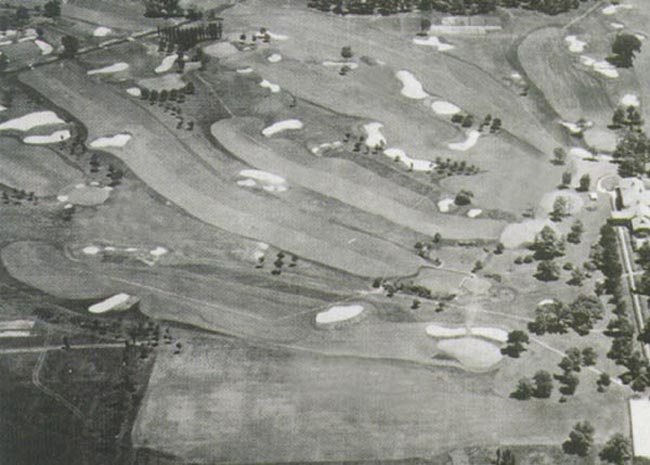
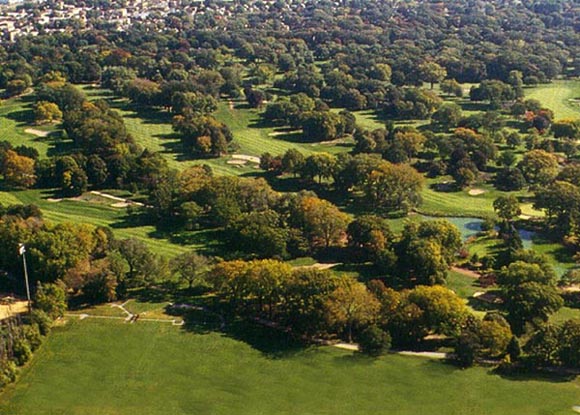
The second set of photographs are of Skokie Country Club, Chicago, Illinois. Designed by Donald Ross, these aerials capture the course in 1922 and again in 1997 before undertaking their highly successful tree removal program.
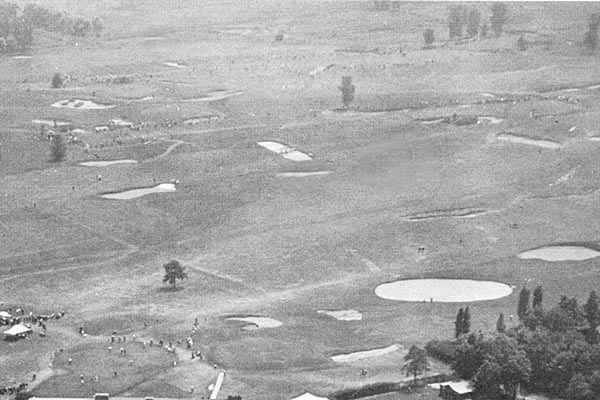
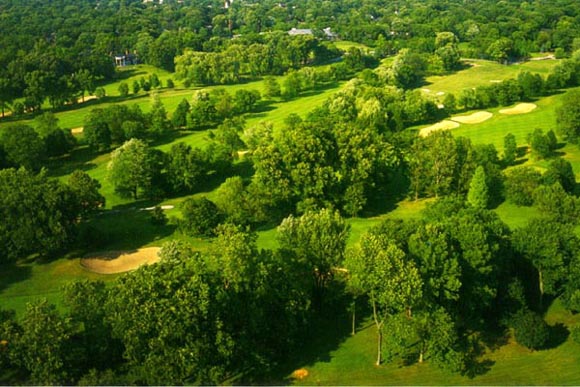
Building a Masterplan
Our duties are twofold. First, we should educate ourselves about the typical characteristics of a Donald Ross design and endeavor to understand his philosophy of the game. Then, we must cultivate this knowledge among our membership. In order to be reasonably informed, I suggest the following books, “Golf Has Never Failed Me: The Lost Commentaries of the Legendary Golf Architect, Donald Ross”; and “Rough Meditations” and “Discovering Donald Ross” by Bradley Klein. Other books include The Golden Age Of Golf by Geoff Shackelford and The Architects of Golf by Cornish and Graves. I also recommend visiting Khris Januzik at the Tuft’s Archives in Pinehurst who houses the history, architectural drawings, and document files of most every Ross course. The Tuft’s Archives is essentially the Donald Ross repository and can be very helpful. I also recommend playing “restored” Ross designs, a list of which can be provided.
Secondly, we should restore and preserve typical Donald Ross features on our course at Blackacre. The following constitutes a small list of common Donald Ross features:
1. Greens – are large in size, square and inverted in shape, and slightly elevated in height. The edges tip down below the fillpad. (Note: Today many of his greens have become even smaller in size and round due to machine mowing instead of hand mowing, while they are also more elevated due to years of top-dressings.)
2. Sand Bunkers – have flat bottoms with raised faces of coarse grass. (Note that fairway bunkers are easily seen from the tee and greenside bunkers are usually built into the base of the green. Also note that they may perhaps be set further back than originally, because of the fact that green sizes have generally shrunken over the years.)
3. Fairways – are usually uneven with crater-like hummocks providing variations in stance and lie. Fairways are usually spacious and wide with elaborate S-shaped curvatures.
4. Collection Areas – usually surround the greens effectively enlarging green size and promoting run-up shots and pitches.
5. Non-Penal Approaches – Trees are used merely to frame a hole while fescue grasses are long only in front of the tee and through collection areas, but at a height that the balls will not be continually lost.
6. Options – Every player should have options and choices of shots. Although there are many routes to a hole, there is but one optimum route. Bailout shots are prevalent.
7. Holes – rarely will you find parallel hole designs; the routing always flows. Par 3’s were used on rugged terrain. There are long par 3’s and many short (uphill) par 4’s, (opening holes were usually downhill par 4’s), many long par 4’s and reachable par 5’s,usually on flat terrain. Lengths vary and the par was essentially irrelevant. Match-play essentially ruled the game then, and he simply tried to create interesting, thought-provoking holes using the terrain as his guide.
Although these typical Ross characteristics have been disseminated over the years, how can one determine Ross’ specific intent on a single course, such as Blackacre? Locating the original “routing plan” is essential. Fortunately, I have found the only original copy at Tuft’s Archives. Donald Ross’ “green sketches” are also very helpful. Blackacre has already located the green sketches of the original front nine, and they are presently on display. Unfortunately, the ‘green sketches’ of the original back nine are still missing. Old photographs are also revealing, especially old aerial photographs. Typically, one may locate aerials at their County tax office. Your Chamber of Commerce and your public library also houses aerial views. But all too often these sources provide photos, which merely take you back to the 1960’s at best.
Add a new source to your list: Your state’s (North Carolina’s) Department of Natural Resources, Soil and Conservation. They provided me with an aerial photograph of a quadrant labeled 11-1FF/62, hence Blackacre Golf Club in 1939. After cropping, zooming-in and digitally enhancing, I have maintained the most detailed, original source of Ross’ Blackacre that exists today. The original Front 9 and Back 9 are shown below. {Note: The original Front 9 is played as the Back 9 today. Likewise, the original Back 9 is played as the Front 9 today. And for a period between 1928 and 1940, Blackacre used original Hole 14 as the beginning hole and original Hole 13 as the finishing hole, because of their proximities to the Inn. To the displeasure of Ross, (See letter dated May 31, 1924 to Leonard Tufts in Tufts Archives), Mr. Ross states that a locker room in the basement of the Inn would be a satisfactory only as a…. “temporary arrangement, but I am in absolute agreement that the permanent club house should have no connection with the Inn and in laying out the course I shall bear that in mind”. Nevertheless, both aerials depict Blackacre in its youth, just thirteen(13) years of age.}
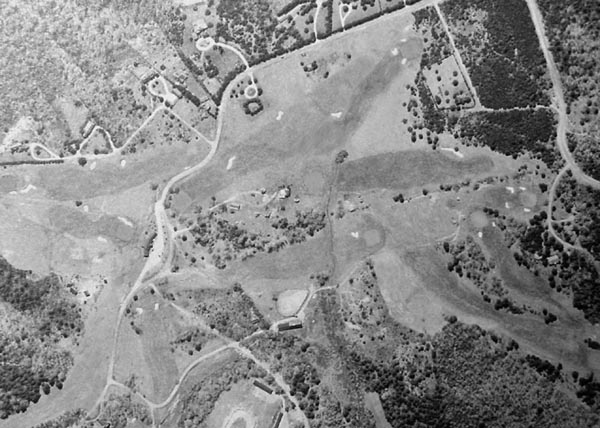
Original front 9
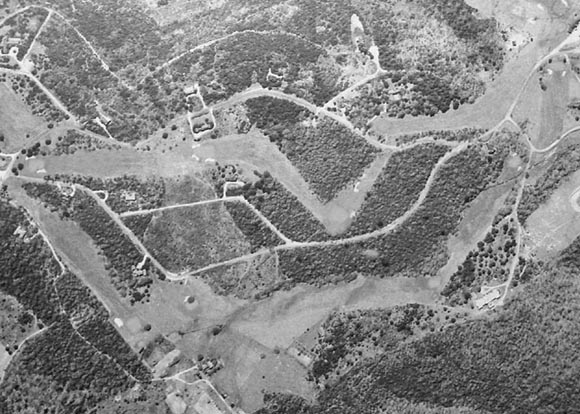
Original Back 9
Careful analysis of these aerials is not required. Upon first examination, it is evident that many years of tree growth have strangled the generous playing spaces throughout the original Back 9. It is also apparent that a tremendous amount of new trees have been both arranged and arbitrarily planted throughout the original Front 9. Restoration in this case is possible! Tree removal services could easily expand our lateral playing areas over any single off-season. Hiring such, with proper supervision of course, should be Blackacre’s top priority.
Bunker Positions
The aerials reveal some minor differences as well. Today, a fairway bunker has been covered-up on Hole 2. Also, the greenside bunker on Hole 2 has been enlarged and extended dramatically. A fairway bunker has been filled-in on Hole 14, and a greenside bunker has been removed on Hole 15. On the other hand, a greenside bunker has been added on Hole 18. The aerials further show that Hole 8 has been re-routed from an additional tee location. Several holes have also been lengthened including, but not limited to, Hole 9 and Hole 16. These changes are not too significant.
On the other hand, Donald Ross’ 1925 Routing Plan of Blackacre reveals significant changes, not only from today’s course, but also from the 1939 aerials. Ross arranged at least fifteen(15) fairway bunkers throughout Blackacre in his 1925 Routing Plan which do not exist on the 1939 aerials of the course. These missing fairway bunkers are known as ‘cross bunkers’ or ‘carry bunkers’, which were typical of the Ross style. Thus, a couple of questions are posed: First, to what extent did Ross actually follow his ‘Routing Plans? Secondly, is it possible that these missing bunkers were never constructed at Blackacre in the first place?
It is also important to remember that Ross, as an architect, was the ‘client’ when designing golf courses. Thus, Ross was restricted to carry out the wishes of the club. His ‘routing’ was the substance, the ‘brick and mortar’ of his design. Evidence reveals that Ross was not too willing to alter his routing when requested to do so by a club. In contrast, bunkers were merely ‘ornamental’ to Ross; therefore, he was more flexible with their use and positions. Likely, Ross would be more willing to deviate from his routing plan with regard to ‘ornamental’ issues, such as bunkers, when requested to do so by a club. Thus, it is certainly possible that the missing fairway bunkers were never originally constructed at Blackacre, especially if Mr. Tufts asked Ross to delete them.
Brad Klein states that this scenario is possible but unlikely. Because there is already a large body of evidence at other Ross courses across the country which conveys that Ross most always followed his Routing Plans in a meticulous manner, there is a presumption that he followed the Routing Plan at your home course as well. Klein further states, these bunkers were probably abandoned and covered-up early in Blackacre’s youth. Bunkers were very expensive for a club to maintain, and during the Depression, courses throughout the country abandoned and filled in bunkers for financial reasons. More bunkers were probably covered-up and abandoned in the 1930’s than all the other decades combined. The Routing Plan reflects Ross’ true design ‘intent’, thus worrying about whether these bunkers were originally deployed is insignificant.
Many restorationists, such as Ron Pritchard, are purist in that they insist on returning all bunkers shown on a Ross’ Routing Plan to their original positions today. By contemporary standards, a lot of these reestablished bunkers typically fall short of landing areas, but nonetheless ‘are helpful in shaping and orienting shots’, according to Pritchard. Brian Silva, who is presently restoring Augusta Country Club, stated ‘we won’t be moving fairway bunkers further down the fairways to accommodate for today’s playing distances’. Silva explained, ‘Ross used a random bunker approach which all golfers must negotiate regardless of length’. ‘Ross simply sprinkled these bunkers throughout fairways’.
Other restorationists, such as Tim Liddy, attempt to retrofit these original bunkers to contemporary standards. Liddy, therefore, recreates and moves bunkers, which were once 140 yards from the tee, to 190 yards from the tee to account for today’s driving distances. Better yet, he moves the tees back where possible to create this yardage. Restoring these alterations at Blackacre is certainly possible; however, it would be expensive as well. An architect would be required! Blackacre must establish a long-range masterplan and determine priorities. If restoring these original bunkers ever becomes a priority, then we must decide whether to restore them in their precise locations or extend them further to meet today’s standards of length. In either case, hundreds of trees must first be removed so that these bunkers would properly fit.
Tee Boxes
The classic tee model is simple. Tees should be long and rectangular in shape and should present the golfer with level lies. Many front tees and back tees at Blackacre are presently uneven causing many variations in stance. How awkward! Our superintendent has leveled many tees at Blackacre; however, he is limited to restoring merely two or three every off-season. Instead, I recommend hiring a laser-grading specialist who can level our tees in a more efficient manner. The best work is done by Bob Rogers of Bob Rogers Laser Leveling, Inc. out of Clemson, South Carolina. Mr. Rogers and his staff can level between seven (7) and ten (10) tees in a single day. His fees are reasonable as he either charges a flat fee of $750.00 per day or $ .10 per square foot. At Blackacre, the latter alternative would be advisable since our tees are small in size.
Little preparation work is required. First, a superintendent must de-sod the tees at issue. Then, depending on the size of the tee, he must distribute a mix of approximately eight (8) yards of sand per four (4) yards of top-soil. The superintendent must specify which direction to place a 5% slope necessary for proper drainage. Bob Rogers does the rest, both leveling and shaping the mix in the classic mold.
Laser-grading is basically a modern method of restoring classical tee box features. Laser-graders are efficient and inexpensive. Hiring one could certainly free-up some time for your superintendent to focus on other priorities at hand
Greens
Our greens are also very different today. The aerials and Ross’ sketches reveal that Blackacres’ original greens have changed in size and shape. Typically, Ross designed many intricant variations of square-shaped greens. Both the original green sketches and the aerials reveal that Blackacres’ greens were once square. Until the 1960’s, superintendents could easily maintain this square shape, because walking hand-mowers were utilized. Thus, sharp turns could be handled and attention to detail could be devoted to the intricacies of his shapes. The advent of the riding machine mowers and the triplex mowers has led to a rounding off of the green surfaces. Today Blackacres’ greens have been reduced to little more than nondescript ovals or circles.
Today Blackacre’s greens are much smaller as well. The original green sketches convey that the average green length was eighty(80) feet, while the average width was approximately seventy-five(75) feet. In measuring random greens at Blackacre, today the average green length is sixty-eight(68) feet and the average width is more or less sixty(60) feet. So we have lost a few feet of green space (15%) at the ends. That is not so much! But consider the fact that the greens today are round, instead of square, and one shall realize just how much corner acreage of green space has been lost. Therefore, many strategic corner pin locations have been lost as well. (See Exhibit below)
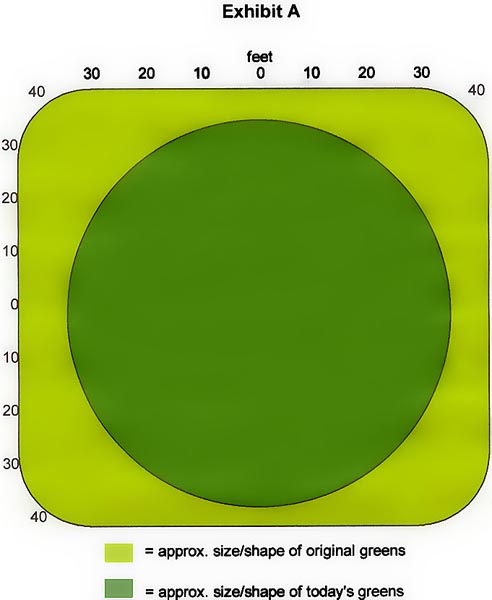
The aerials support this calculation. Just look at the many original greenside bunkers in 1939! These bunkers were in fact greenside due to their close proximity to the greens. Today, however, many of these same bunkers are set back away from the greens. They are clearly not greenside anymore! The reduction of green size, especially at the corners, is the only reasonable explanation for this apparent separation.
Not only are our greens much smaller and of a different shape, to complicate matters even further, our greens are much more elevated than were our originals. The maintenance practice of top-dressing is necessary for two main reasons: to eliminate “thatch” or root build-up and to assist with surface drainage through the sub-layers. The problem is that years of adding large amounts of sand have had a tendency to elevate greens and to create steeper (back to front) slopes. For example, Ross notes on his green sketches that Hole 15 at Blackacre should have only one(1) foot of elevation change between the front and back level of the green. Today, there is between two(2) and three(3) feet of difference.
Furthermore, Ross preferred to grade the slopes in his greens at a maximum of six (6%). Today, a six (6%) grade is considered extreme. Ross could afford such a grade of slope in his day, because walking mowers could simply not clip the putting surfaces tighter than ¼ inch. As a result, bent grass greens would not have rolled faster than 5 or 6 on today’s stimpmeter. This grade of slope would be demanding but manageable under these conditions. Today, however, these slopes have been magnified due to years of top-dressings. The grade of slope is fast approaching ten (10%) on many of our greens, such as the left portion of Hole 7, the front half of Hole 9, the front portion of Hole 12, and the front half of Hole 18. This problem is further compounded by today’s lowered mowing heights and increased putting speeds. Consequently, many pin locations on Blackacres’ greens are unusable today because of these slopes. Thus, our greens have not only been reduced in size and shape, but they have also been reduced in “usable space”. Many old pin locations have been destroyed.
Can our greens at Blackacre be restored? Softening today’s greens is not a simple process. An architect and approximately $800,000.00 is required. Taking a foot out of the top end of the slopes and adding a foot at the bottom end of the slopes is necessary to create a more level surface thus recapturing usable green space. By taking the top slope down a foot, the fill pad will be penetrated and drainage patterns could be destroyed. By building the bottom slopes up a foot, it could have a marked effect on playability from an approach area since greens would have to be raised. Basically, the entire fill pad would have to be cored out, rebuilt, and outfitted with proper subgrades of gravel, peat and sand. Enlarging today’s greens to their original sizes is not a simple process either. To achieve even marginal adjustments, the surrounding area must be graded out some 40 to 50 feet in order to tie the contours in properly. It requires major reconstruction and a major commitment from the membership.
Maintenance Practices
Maintenance practices can also alter a classic design. Maintenance and architecture work hand and hand. Brad Klein states in Discovering Donald Ross that superintendents can be faulted particularly when they allow two(2) inches of blue grass rough to grow around their Ross greens, thereby separating the greens from the surrounding collection areas and greenside bunkers. Ross did not design inverted, bowl- shaped greens with sloping edges to have the ball engulfed by rough a few feet away. Sometimes superintendents find beauty in the contrasting grass heights; other times superintendents lack the equipment to properly shave these slopes and contours; but more often than not the rationale is to facilitate ease in maintenance and help defend par. Regardless of the reason, rough in close proximity to Ross greens compromises design integrity. Unfortunately, Blackacre maintains blue grass rough around most all of their greens. On August 5, 2001, the rough measured between eight(8) and ten(10) inches in height merely five(5) feet away from the greens on hole 4, hole 5, hole 12, hole 15, hole 17 and hole 18. Many other collection areas and greenside bunkers are buffered by this blue grass rough. Otherwise, they would naturally receive more balls as intended. A good rule of thumb is never to let a ribbon of rough, regardless of its height, prevent a ball from running its due course into a collection area or greenside bunker. After all, the point of these areas is to have them ‘in play’ as opposed to having them protected by rough.
Rough in close proximity to Ross greens compromises playability as well. Skill, touch and shot-making abilities are always required from collection areas and greenside bunkers. These attributes are inherent to a classic design. Skill, touch and shot-making ability are all but lost when trying to negotiate with the rough which presently guards and suffocates these areas. This rough is inherently penal in that virtually all golfers, regardless of skill, have little chance at recovery. This style is foreign to a classic design. The remedy here is simple and should be a priority. We should cut the grass around the greens so that the ball will roll-out with the natural ground contours constructed by Ross.
The same analysis applies for the 1-inch of fairway grass which currently collars our greens. More often than not, a ball gets caught-up against these collars instead of rolling-out with the natural green contours to a collection area. In this situation, a good shot is penalized. Instead of being required to pitch the ball toward the hole, golfers at Blackacre are required to attempt a number of putter blade options, such as toeing or beating down on the ball, all while still on the green. This is foolish! According to Brad Klein, ‘Superintendents should definitely extend Ross greens below the edge of the fillpad so that the putting surfaces tip outward onto downsloping ground’. Only then would a ball have the momentum to penetrate the fairway collar to the green and naturally roll its course. Another option would be to create a secondary cut extending below the edge of the fillpad onto the downsloping terrain. This would certainly bring Ross’ ground features, such as collection areas and greenside bunkers, back into play. Plus, they will appear bowl-shaped as designed. (See Exhibits below)

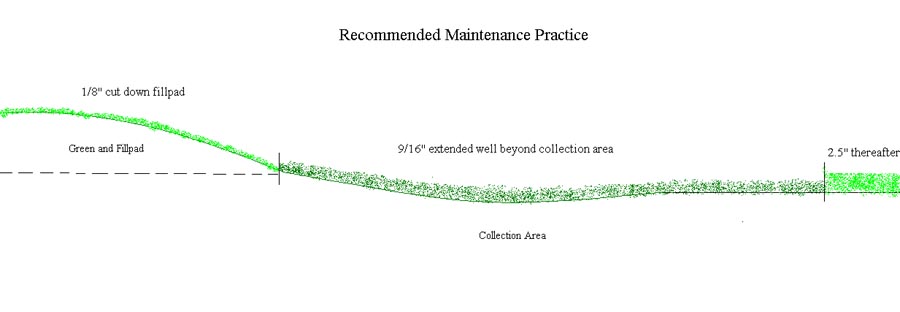
Pat O’Brien, turfgrass management specialist with the USGA, also advised our superintendent to extend the present grass levels out away from the hole as shown above. In doing so, O’Brien recommended some proper grass heights as well. Ideally, our greens should be cut at 1/8″, our fairways should be cut at 9/16″, and our rough should be cut at 2.5″. O’Brien asserted that these grass heights would improve playability tremendously.
On classic golf courses, maintenance endeavors need to yield ‘natural’ results. The classic golf course tended to appear “natural and untouched”. The topography of a site was essentially left in its natural state as classic architects directed the routing of a design. By utilizing the preexisting contours of the land and natural elements, such as steep hills, ravines, creeks and rugged terrain, the classic architect was able to hide his hand in the construction of a course. Most green sites, tee sites, landing areas, and bunker positions naturally melded in with its surroundings.
In contrast, modern golf courses tend to appear unnatural or artificial. Due to the evolution of mass-scale earthmoving equipment, the modern architects simply bulldozed their way over and through a natural landscape. Steep hills may be leveled, ravines may be filled-in, creeks may be piped underground or rerouted, and rugged terrain may be graded. While the classic course is a contrivance of man and nature, the modern course is a contrivance of man and machine. Consequently, green sites, tee sites, landing areas and bunkers all possess the manufactured look.
Because of construction technology, it is not difficult to distinguish between a classic design and a modern design. Forget about trees, strategic choices and options, and green shapes and sizes. These elements only tell part of the story. Simply distinguish between “natural” and “creative” landforms. It is not difficult. An untrained eye can differentiate the vertical shaping and dished-out look of Tom Fazio or the mounding and the bold contouring of Pete Dye from the simplicity of the natural setting. Likewise, it is just as easy to identify “creative landforms” on classic designs. They are the product of years of alterations at the hands of superintendents and greens chairmen. The goal of the restoration process is to return such artificial elements to their natural state or appearance.
At Blackacre, the installation of subgrade transit pipes has essentially alleviated our perceived drainage problems. However, Blackacre presently possesses a number of “creative landforms” as a result of these drainage efforts. Just look at the undulations and depressions to the left of the green on Hole 12. Just look at the bold contours behind the green on Hole 15. Just look at the lunar-shaped mound next to the creek on Hole 8. Expect a similar outcome to the left of Hole 16 as well. These are examples of “creative landforms”, the type which would be revered at a modern design, such as the Stadium Course at Sawgrass; however, these creative landforms are conspicuously out of place at Blackacre.
Brad Klein states that all too often the “form” of the landscape has been determined by the “function” of the alteration. Unfortunately, many superintendents do not care whether you have “creative landforms” in a natural setting, so long as the drainage problems are curtailed. This prevailing attitude has transcended many natural, classic designs into merely functional golf courses. Klein states, in order to preserve the classic design, the “function” of an alteration should only be implemented if it can follow the “form”, in this case, the natural form of the land. Thus, “function” should always follow “form”, not vise versa. Hence, a drainage problem can be alleviated only if the resulting form can be naturally integrated with its surroundings. Many classic designs, including Blackacre, have failed miserably in this respect.
Simply put, natural landforms are appropriate on classical designs. Creative landforms are appropriate on modern designs. However, creative landforms are only appropriate on classical designs if they are integrated with the surroundings in a way that they appear natural to the setting as opposed to man-made.
A cart path, however, constitutes the epitome of a creative landform. There is no way to mask its identity. A cart path is inherently unnatural; therefore, many argue that they don’t belong on the classic design. The last thing that a golfer wants to see when looking at a golf hole is a protruding cart path in the line of fire. Worse yet are cart paths that vertically transverse the entire fairway of a hole. The biggest sin, however, is to construct paths which horizontally cross a hole or the golfer’s line of vision. Cart paths simply stick out like a sore thumb in a natural setting. (See Exhibit below)

Blackacre fortunately has not constructed a lot of cart paths. However, Blackacre just recently extended an old existing cart path close to the green on Hole 1, fifty(50) yards back down the fairway. As a dogleg right par 5, this cart path presently crosses your line of vision on the tee and comprises a portion of the typical landing area. Moreover, this cart path is eight(8) to ten(10) feet wide as opposed to our original five(5) foot widths. Nothing can be more obtrusive and conspicuous! Blackacre should do away with this cart path extension immediately.
Typically, if cart paths are a necessary function of a hole, they should be constructed so that they turn outward away from the tee, return inconspicuously at the green and are virtually out of sight in between. Blackacre accomplished this effect a few years ago on Hole 12 where the cart path is virtually hidden by trees. Unfortunately though, matters are compounded by the fact that these trees desperately need to be removed. If so, then Blackacre will have cart path issues again. Basically, this path should not have been employed originally. This scenario serves as an example of how important it is to have an educated membership, superintendent, and leadership with a restoration masterplan.
Other changes in maintenance practices can help restore Blackacre. In Discovering Donald Ross, Klein suggests that many superintendents today are attempting to grow some of the older grasses back on their courses. Paul Jamrog championed this project at The Orchids Club. Jamrog states, “What had been seeded into the golf course when Donald Ross designed it was mainly fescues. At that time they did not have the variety of grasses that we have available now. Really, the look of the golf course would be to let those fescues grow up in peripheral areas and let them go dormant in the summer months. That’s the brown type of look, the Scottish look, that had been intended for a Ross Course”. In 1996, our superintendent grew this fescue, perhaps excessively, around Blackacre. The membership disapproved because it was too penal and affected speed of play. In a modest fashion, it definitely should be reinstated for aesthetic reasons. Varied playing surfaces appear dynamic, yet natural. There is simply nothing more beautiful and original than tall, sweeping, brown grass dispersed outside the typical playing areas of the golf course, even more so than a lush green course where every inch is immaculate.
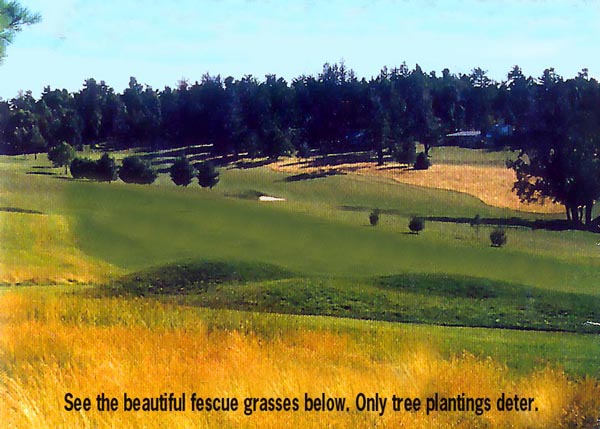
There are yet other methods of restoration that contribute to “the look”, the original look of a classic design. Flagsticks come in many styles; however, Lesco, Inc. offers the traditional, wooden-style flagsticks which golfers would have found in the early part of the 20th Century. The antique ‘Woody Sticks’ are thick and short being just six(6) feet in height. They come in wide, green/white stripes and wide, black/white stripes. They are presently used at venues throughout Scotland and Ireland and are catching-on at classic designs throughout our country as well. Ryan Blair, superintendent at Holston Hills, claims that these flagsticks contribute significantly to the traditional look. I agree! Blackacre should purchase these sticks at their earliest convenience for their golf course, putting green, and practice areas. The six(6) foot ‘Woody’ flagsticks cost $32.00,while the thirty(30) inch ‘Woody’ putting green sticks cost $14.00.

Conclusion
Contrary to our membership’s opinion, Blackacre is far from an untouched, original design. This dissertation makes a resounding case that change is constant and golf courses are always evolving. The point is to anticipate such changes and to plan for the long term rather than simply responding to the whims of this or that individual at the time. Restoration efforts are widespread at clubs throughout the country. As shown above, there are many methods of restoring your original design. Clubs simply must develop a long-range masterplan, a budget, and a proposed timetable with priorities to determine which original features are ‘worth’ restoring and when. From a ‘value added’ standpoint or a ‘cost/benefit analysis’, massive tree removal programs are always at the top of the list. Proper maintenance practices are also necessary, the guidelines of which should be established promptly. Day-for-hire specialists and classic course accessories would compliment the restoration effort. The preservation of our bunkers and greens however would require an architect. These decisions should not be taken lightly. It is a major financial undertaking and requires the commitment of the membership. In this case, put out a call for architectural services and invite competition for the contract. Club factions and club politics present the only major hurdle. This is precisely why educating the membership is so critical to the restoration process. Presently, Blackacre has far too many other pressing issues.
Best of luck with your club’s restoration endeavors!
Note: Blackacre Golf Club is a fictitious Donald Ross course. The situation described above
does however depict real issues affecting many classic designs across America. Not meant for
publication.
The End


